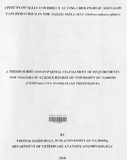| dc.description.abstract | Various endogenous substances are involved in the control of nociception both at the
segmental and at the higher levels of central nervous system. These substances include
acetylcholine, which modify pain processing in a wide variety of experimentally induced or
clinically related pain states by interacting with specific receptors. Acetylcholine is the
endogenous ligand for the cholinergic receptor system with muscarinic and nicotinic receptors,
and systemic or intrathecal stimulation of these receptors results in modulation of pain responses
in animals and humans.
In this study, the role of cholinergic system in nociception in the naked mole-rat
(Heterocephalus glaber) was evaluated. The study explored the antinociceptive effects of the
muscarinic receptor agonist, oxotremorine (10, 20, 50 and 100 ug/kg body weight) and the
nicotinic receptor agonist, epibatidine (0.5, 1,2 and 3 ug/kg body weight) using three commonly
used nociceptive tests. These were the formalin (20 Ill, 10%), the hot plate (60°C) and the tail
flick (56 °C) tests. To elucidate possible interaction with opioidergic system, a general opioid
receptor antagonist, naloxone, was simultaneously administered with the cholinergic agonists.
Muscarinic (atropine) and nicotinic (mecamylamine) blockers were used for antagonistic
reactions.
In the formalin test, the duration the animal took lickinglbiting the injected paw was
scored in blocks of 5 minutes for a duration of 60 minutes, whereas in the hot plate test the
latency (s) the animal took to react to the thermal pain was recorded. In the tail flick test, tailflick
withdrawal latency (s) was scored. The selected high doses (20, 50 or 100 ug/kg) of
oxotremorine induced a statistically significant (P<0.05) dose-dependent reduction in the mean
time spent licking/biting the injected paw in both the first and second phases of the formalin test.
In both early and late phases of formalin test, the effect of oxotremorine on the mean time spent
lickinglbiting the injected paw was reversed by atropine.
The animals treated with epibatidine (1, 2, or 3 ug/kg) showed a statistically significant
(P<0.05) reduction in the mean time spent in licking/biting the injected paw in both early and late
phases of the formalin test. When mecamylamine was administered together with epibatidine (2
ug /kg), it significantly increased the mean time spent in lickinglbiting the injected paw in both
phases of the formalin test. In the hot-plate test, oxotremorine (20, 30 or 50 ug /kg) and
epibatidine (1, 2 or 31lg/kg) caused a significantly different dose-dependant increase in the hotplate
response latency. The effects of oxotremorine and epibatidine were blocked by atropine and
mecamylamine, respectively. In the tail-flick test, oxotremorine (20, 30 or 50 ug /kg) and
epibatidine (1, 2 or 3Ilg/kg) caused a significantly different dose-dependant increase in the tailflick
response latency. In the same test, the effects of oxotremorine and epibatidine were blocked
by atropine and mecamylamine, respectively. In all the three nociceptive tests, naloxone in
combination with oxotremorine or epibatidine exhibited synergism of their effects.
Administration of atropine, mecamylamine or 'naloxone alone did not show any significant effect
on the nociceptive behaviour in any of the three tests.
In conclusion, the study showed that oxotremorine and epibatidine are effective
antinociceptive drugs in the naked mole-rat and that naloxone is able to potentiate their
antinociceptive effects. The data further reveals that the cholinergic system is crucial in pain
regulation in the naked mole-rat. | en |

